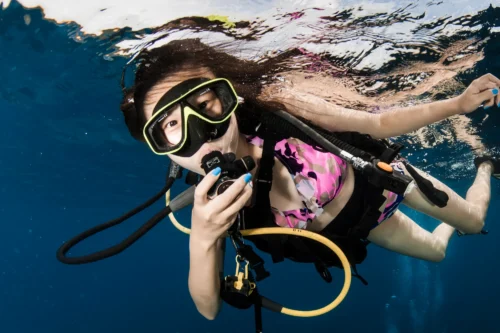Self-Rescue: The First and Most Important Skill of a Rescue Diver
Welcome back to Amadive’s in-depth series on the PADI Rescue Diver course. Before we can learn to help others, there is an unshakable truth in the world of diving: you must be your own first rescuer. A minor problem, when handled with calm, methodical skill, remains just an inconvenience. But if met with panic, it can escalate into a dangerous situation.
This article doesn’t just list skills. We will dive deep into the “why” and “how” of self-rescue. This is the foundation of confidence, turning potential fear into prepared competence, and the first step toward becoming a truly reliable dive buddy.
The Psychology of Self-Rescue: The “Stop, Breathe, Think, Act” Framework

When something goes wrong underwater, the instinctive human reaction is to act immediately—often, to act incorrectly. PADI’s problem-solving framework is designed to combat panic and engage your logical mind.
- STOP: Cease all movement, especially swimming. Unnecessary motion wastes air, increases stress, and can make the problem worse. Just stop and maintain your position.
- BREATHE: Focus on taking slow, controlled breaths. This breaks the adrenaline feedback loop, slows your heart rate, and allows your brain to get enough oxygen to think clearly.
- THINK: Now, analyze the problem. What is actually happening? What is the cause? What options do I have to solve it? Which option is the best and safest?
- ACT: Execute your chosen solution deliberately and calmly. If the first solution doesn’t work, stop, breathe, and think again.
Amadive Pro-Tip: Practice this framework even with the smallest issues, like a slightly foggy mask. Make it your go-to reflex.
Common Underwater Problems and Your Action Plan
Here is how to apply the above framework to real-world scenarios you will learn in the Rescue Diver course.
1. Cramps
- Scenario: You’re swimming along and suddenly feel a sharp, seizing pain in your calf muscle.
- Cause: Dehydration, fatigue, inefficient finning technique, or fins that are too stiff.
- Solution (Stop, Breathe, Think, Act):
- Stop finning. Signal “problem” to your buddy.
- Breathe steadily. The pain is not dangerous if you remain calm.
- Think: I need to stretch the contracted muscle.
- Act: Use your hand to grab the fin tip and pull it towards you, keeping your leg straight. Hold the stretch until the pain subsides. Gently massage the affected muscle. Afterward, proceed with a more relaxed finning style.
- Prevention: Hydrate well before diving, do some light stretching, and use fins that match your strength.
2. Free-Flowing Regulator
- Scenario: Your regulator suddenly begins blasting a continuous, uncontrolled stream of air.
- Cause: Cold water, poor maintenance, or a grain of sand lodged inside.
- Solution (Stop, Breathe, Think, Act):
- Stop. Do not panic and spit out the regulator.
- Breathe. You can still breathe from a free-flowing regulator. “Sip” the air like drinking from a water fountain.
- Think: I am losing air very quickly. I need to switch to my alternate air source and begin my ascent.
- Act: Immediately switch to your alternate air source (octopus). Signal to your buddy that you are “out of air” and signal to ascend. Begin a controlled ascent to the surface. At the surface, close your cylinder valve to stop the leak.
- Prevention: Have your gear serviced annually and rinse it thoroughly with fresh water after every use.
3. Entanglement
- Scenario: You feel a tug and realize you’re caught on a piece of old fishing line.
- Cause: Low visibility, lack of environmental awareness.
- Solution (Stop, Breathe, Think, Act):
- Stop. Cease all movement. Thrashing is the worst thing you can do; it will only make the entanglement tighter.
- Breathe slowly. You have plenty of time and air.
- Think: Assess the situation. Where is the line caught? Can I untangle it myself? If not, how can my buddy help?
- Act: If possible, slowly and carefully work yourself free. If you can’t, signal for your buddy to assist. If your buddy is not near, use your dive knife or cutting tool to carefully cut the line. Always cut the line away from your body, not between you and the line’s anchor point.
The Ultimate Safety Net: Buoyancy and Weight Management
Your ability to rescue yourself is dramatically improved when you aren’t struggling to maintain your position.
- Proper Weighting: Being overweighted forces you to add more air to your BCD, creating drag and causing you to use more energy and air. Perform a proper weight check before diving in new conditions.
- Emergency Weight Drop: This is a last resort, but you must know how to do it. In a critical surface emergency where you cannot stay afloat, ditching your weights will provide immediate positive buoyancy and ensure your safety.
Frequently Asked Questions (FAQ)
- What is the most important self-rescue skill?
- The “Stop, Breathe, Think, Act” mindset. It’s not a physical skill, but it’s the foundation for executing all other skills effectively.
- Should I dive alone if I’m confident in my self-rescue abilities?
- No. Recreational diving always requires the buddy system. Self-rescue skills are so you don’t become a liability to your buddy, not so you can replace them.
Conclusion: Confidence Comes from Competence
Mastering self-rescue skills replaces anxiety with confidence. You will know that, should any minor issue arise, you have the knowledge and training to handle it calmly. This is the first and most essential step on the path to becoming a true Rescue Diver.
Important Disclaimer: This article is for informational purposes. These skills must be learned and practiced under the direct supervision of a certified PADI Instructor during a Rescue Diver course.
➡️ Next, learn to expand your awareness outward: Recognizing and Managing Stress in Other Divers
